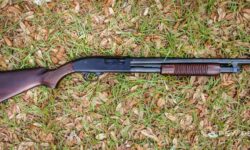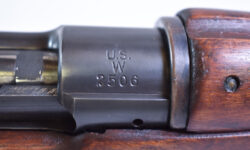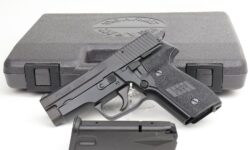7.92x94mm German Anti-Tank Rifle: The History and Specs
In the early years of World War II, the German military was still using anti-tank rifles to combat the threat of Allied tanks. One such rifle was the 7.92x94mm German anti-tank rifle. This firearm was designed to penetrate the armor of armored vehicles, and it saw use throughout the war. In this blog post, we will take a closer look at the history and specifications of this rifle!
7.92x94mm
The German anti-tank rifle was developed in the early years of World War II. It was designed to penetrate the armor of Allied tanks, and it saw use throughout the war. The rifle was chambered for the powerful .30-06 Springfield cartridge, and it had a muzzle velocity of over 3000 feet per second. The rifle could penetrate up to two inches of armor plating, making it a formidable weapon against enemy tanks.
In addition to its use as an anti-tank weapon, the German anti-tank rifle was also used as an infantry support weapon. It saw action in all theaters of the war, and it proved to be a valuable asset to the German military. After the war, many countries adopted this Rifle including United States and Israel.
What is the Panzerbuchse?
The Panzerbuchse was a German anti-tank rifle used during World War II. It was developed in response to the threat of tanks, which were first used in battle during the First World War. The Panzerbuchse was designed to penetrate the armor of tanks and other armored vehicles. It was first used in combat during the Battle of France in 1940, and later saw action on the Eastern Front and in North Africa.
The Panzerbuchse was an effective weapon against Allied tanks such as the British Matilda and American Sherman. However, it was less effective against newer types of tank such as the Soviet T-34. The Panzerbuchse was replaced by more powerful anti-tank weapons such as the Panzerschreck and Panzerfaust in the later years of the war.
Despite its effectiveness, the Panzerbuchse had some drawbacks. It was a large and heavy weapon, which made it difficult to transport and deploy in combat. It also had a slow rate of fire, which made it less effective against massed tank attacks. Nevertheless, the Panzerbuchse was an important part of Germany’s anti-tank defense during World War II.
What caliber was the Panzerbuchse?
The Panzerbuchse was a 41mm anti-tank rifle. It was developed by the German company Rheinmetall in 1934 and was used by the German military during World War II. The Panzerbuchse was effective against Allied tanks such as the British Matilda and the American Sherman, but it was not effective against the Soviet T-34. The Panzerbuchse was replaced by the Panzerschreck in 1944.
The Panzerbuchse had a range of about 500 meters (550 yards). It could penetrate up to 60mm of armor at 100 meters. The weapon weighed about 30 kg (66 lbs), and it could be fired from either a standing, kneeling, or prone position. The gun was equipped with a telescopic sight and had a magazine capacity of five rounds.
The Panzerbuchse was a successful weapon, but it had some drawbacks. The main drawback was its size and weight, which made it difficult to transport. Additionally, the gun’s effective range was limited by its low muzzle velocity.
Despite its drawbacks, the Panzerbuchse was an important weapon in the German arsenal during World War II. It was used to great effect against Allied tanks, and it helped the Germans to maintain their superiority on the battlefield.
How effective were anti tank rifles in WW2?
The effectiveness of anti tank rifles in WW II varied depending on the type of tank they were used against. German tanks, for example, were designed to be resistant to small arms fire, so the anti tank rifles typically used by Allied forces were not as effective against them.
However, Soviet tanks were not as well-armored, so the anti tank rifles used by German forces were more effective against them. In general, though, anti tank rifles were not very effective against tanks during WW II. This was due to the fact that most tanks were simply too well-armored for the small caliber bullets fired by these weapons.
Additionally, the long barrel length of these weapons made them difficult to maneuver in close quarters combat situations. For these reasons, anti tank rifles were generally replaced by anti tank missiles and other more effective weapons in the later stages of the war.
Is 7.92 the same as 8mm?
The simple answer is no, they are not the same. The difference between the two is that one is a metric measurement and the other is imperial. In Europe, most countries use the metric system which uses meters (m) and centimeters (cm) to measure length. On the other hand, England and some of its colonies (including America) use the imperial system which uses feet (ft) and inches (in).
So when it comes to firearms, ammunition manufacturers usually specify caliber in millimeters for European markets and inches for American markets. This can often lead to confusion because people assume that since “mm” is bigger than “in”, then a higher mm number must be equal to or greater than a lower inch number.
For example, the common “Glock 17” handgun has a barrel diameter of 17mm. This is actually equal to 0.669 inches which is slightly larger than a “Glock 19” whose barrel diameter is 15mm or 0.591 inches. In the world of firearms, the larger the caliber, the bigger the bullet and usually (but not always) the more powerful the gun.
So when someone says they have an “eight-millimeter” gun, they could be referring to either an actual metric measurement or an imperial measurement and it would be helpful to ask for clarification.
Are 7.92mm rifles still made?
Yes, there are a few companies that still make them. However, they are not as popular as they once were. There are many newer and more advanced designs on the market today. But for some shooters, there is nothing like the classic feel of a good old fashioned German Mauser. So if you’re looking for one of these rifles, you can still find them out there. Just be prepared to pay a bit of a premium for one. They are truly collectors items at this point. But if you’re lucky enough to find one in good condition, it will be well worth the investment.


